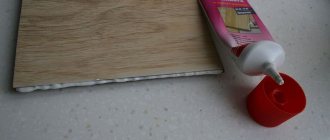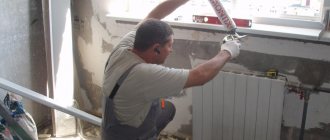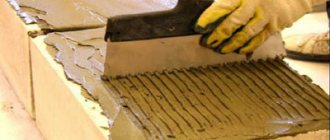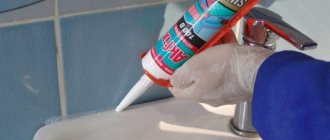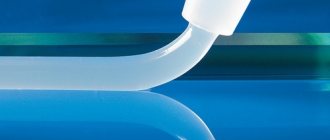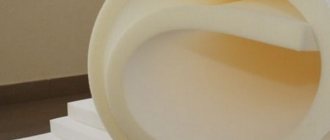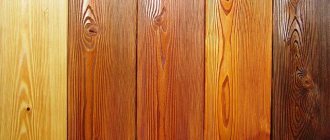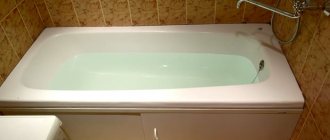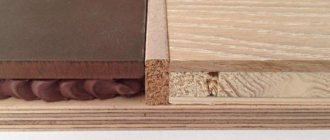Whatever type of construction work you carry out, the sealing stage inevitably comes, which makes cracks and joints impenetrable to moisture, cold and atmospheric influences and protects building structures from mold and mildew. But for each type of work you need to select a suitable sealant.
Where one sealant works perfectly, another may be useless.
If you select even the best quality sealant incorrectly, it can quickly peel off, turn black, and begin to leak moisture. Thus, time, money and effort will be wasted.
In this article, Sika technicians explain how to select sealants for interior and exterior applications according to the required application.
What it is
A distinctive feature of the mixtures is the water content. The moisture evaporates, forming a durable sealed layer. The basis of the products is polymethylacrylate, which belongs to the category of plastics. The formed seam has good elasticity, uniform filling and resistance to stress. Acrylic sealants come in classic white, transparent and colored. The formula of sealants includes several substances:
- To ensure optimal viscosity, thickeners are added to the aqueous dispersion.
- Acrylic sealants are protected from moisture, temperature changes and aggressive environments by plasticizers and fillers.
- Antiseptics give the mixtures antibacterial properties. The composition also includes surfactants, defoamers and ammonia solution.
Manufacturers produce sealing products in the form of pasty and viscous-fluid substances. The scope of use of acrylic sealants is very wide. They are used for industrial and domestic purposes, during internal and external construction work. Thanks to the special properties of the materials, the frozen mass provides reliable protection against the penetration of cold and does not allow moisture and dust to pass through.
Important: Acrylic sealants have a long service life, which is 15 years or more. The compositions are universal, therefore suitable for performing a wide range of repair, installation and construction work.
General information about sealants for joints in concrete
The high-quality sealants on the market are produced using the latest innovative developments. The action of construction sealants is aimed at water- and air-tightness of expansion joints in concrete floors. They are made on the basis of modified polymers, synthetic, natural rubber, and other compounds that give the material increased elasticity. This is the main requirement for construction raw materials. But different types of acryplast have elasticity, with different properties.
The bulk is represented by types, which differ according to the formula, area of use, shrinkage properties, adhesion, strength, main components, etc.
According to operating conditions, concrete sealant is divided: for civilian objects, apartment buildings; industrial construction; works under water; hydraulic concrete structures; sewerage and treatment facilities.
Acriplasts for concrete joints are also classified according to design features:
View this post on Instagram Posted by svitfarb.com.ua (@svitfarb) Aug 30, 2021 at 12:32 PDT
Advantages and disadvantages
For convenient use, acrylic sealant is produced in compact tubes. The product is easy to hold while working due to its light weight. Another form of production of compositions is tubes and cartridges, which must be applied using a mounting gun. Professional sealants are used for large-scale work, and small tubes are used for minor home repairs. Some mixtures are supplied in plastic buckets that hold several kilograms. Such products are applied with a spatula, treating large surfaces and bases. The process of vulcanization or polymerization of compositions occurs as a result of moisture evaporation.
Advantages of acrylic sealants:
- Ecological cleanliness. The absence of solvents in the compositions eliminates the content of dangerous toxins, so acrylic mixtures are best suited for interior work. During processing, the substances do not release the characteristic pungent odor and volatile substances into the atmosphere.
- High adhesion to various materials is one of the main properties of acrylic sealant. Universal products interact well with metal, wood, plastic, tile, ceramic surfaces with a smooth base or porous structure.
- Good vapor permeability. After applying the acrylic product, the surface becomes solid, but does not create a “greenhouse” effect. It is allowed to use acrylic sealant to seal gaps in window frames, door structures made of wood, plastic or metal.
- Easy to apply. Acrylic sealant is supplied in tubes, cartridges or buckets. It can be applied using a gun or spatula. The remaining mixture can be easily removed with a clean rag, and if the product has hardened, the excess can be cut off with a knife. The main rule of application is compliance with the temperature regime.
- Resistance to ultraviolet rays and high fire safety. According to the fire resistance class, acrylic compositions are classified as non-flammable mixtures due to the absence of solvents in them. When exposed to sunlight, sealants do not fade or crack.
After the acrylic layer has dried, the surface can be painted. The mixtures are presented in a wide range of colors. They are characterized by high aesthetic appeal and durability of the coating. Another advantage of acrylic-based sealants is their affordability. The disadvantages of the products include low resistance to moisture.
Attention: Despite the fact that “moisture-resistant” sealant may be indicated on the packages, prolonged contact of the composition with water should not be allowed, as a result of which the treated seams are gradually destroyed. Acrylic products are not the best choice for rooms with high humidity - bathrooms, showers, baths, saunas, kitchens.
The best sanitary sealants
Makroflex SX101
Macroflex sanitary sealant based on silicone was developed by specialists for sealing gaps in rooms where humidity is higher than normal (bathroom, bathhouse). It contains fungicidal additives that prevent the proliferation of fungal deposits and molds. The product is frost-resistant and heat-resistant.
| Volume, ml | 290 |
| Color | white, black, beige, brown, transparent |
| Manufacturer | Estonia |
| Type | silicone |
| Advantages | Flaws |
| Moisture resistant | Unpleasant smell |
| Resistant to biological damage | |
| Good adhesion (sticking) |
Review of Makroflex SX101
TANGIT S 400
“Tangit” engineering sealant with a paste-like density has an acetate composition and is famous for its excellent adhesion (sticking) and indestructibility to fungal formations and molds. According to consumer reviews, a special feature of this product is the ability to order any color.
| Volume, ml | 280 |
| Color | transparent |
| Manufacturer | Belgium |
| Type | silicone |
| Advantages | Flaws |
| Durability of sealing | Rarely found on the Russian market |
| The composition contains fungicides | |
| Good adhesion (sticking) |
Belinka Belsil Sanitary Acetate
Thanks to the consistency of the sealant in the form of a paste, it is possible to perfectly fill gaps and cracks of any size. Finishers note that this is one of the best sealing agents used for laying ceramic tiles. The dried seam does not shrink; in addition, due to its viscosity, the sealant is washed out with water.
| Volume, ml | 280 |
| Color | white, transparent |
| Manufacturer | Slovenia |
| Type | silicone |
| Advantages | Flaws |
| Antifungal properties | Long drying time |
| Good adhesion to tiles | Strong vinegar smell |
| Uniform application |
Review of Belinka Belsil Sanitary Acetate
Bostik Sanitary Silicone A
In our country, this sealant is little known, although in terms of production volume it is one of the world's top five. The sanitary silicone product has excellent adhesion (stickiness) and high strength of the applied joint. The surface on which the product is applied must be flat and free of dust and grease. Sealant can replace grout when laying ceramic tiles.
| Volume, ml | 280 |
| Color | 11 colors, including: white, clear, jasmine, pergamum |
| Manufacturer | USA |
| Type | silicone |
| Advantages | Flaws |
| Strength, elasticity | Can't paint |
| Good adhesion | Vinegar smell |
| Water resistant |
Review of Bostik Sanitary Silicone A
Specifications
The consistency of the acrylic mass is a viscous and viscous substance with minimal fluidity when used on vertical surfaces. After hardening, it acquires optimal strength and resistance to deformation loads. The composition has good adhesive properties and easily adheres to brick, plaster, wood, and plasterboard substrates.
Technical characteristics of sealing acrylic sealants:
- Processing seams with a width of 0.6-5 cm, provided that the thickness is equal to half the width of the seam.
- The average material consumption under optimal application conditions is 0.065-0.073 kg/m2, approximately 70 g.
- It is allowed to use acrylic products at a temperature of -40+120°C, application at +4+32°C.
- Primary setting with the treated surface occurs after an hour, complete hardening of the seam with a thickness of 10-12 mm occurs after 3-4 weeks.
- Degree of frost resistance - at a temperature of -15 degrees it can withstand up to five freezing/unfreezing cycles.
- Sealants have good tensile strength, but do not tolerate contact with moisture well.
- The shelf life in hermetically sealed packaging is 12 months, container - cartridge, tube, tuba, plastic bucket.
The widespread use of acrylic sealants is due to the environmental safety of the products and the absence of toxins and solvents in the composition. First of all, it is recommended to use mixtures for interior work.
Sealant for expansion joints of concrete floors
Germotex is a two-component polyurethane elastic sealant intended for expansion joints of concrete foundations.
Germotex - has high strength of attachment to concrete, brick, glass, rubber, wood, as well as metal surfaces, thereby ensuring the durability of building structures and allowing you to save on repeated repairs.
Possessing excellent elasticity, polyurethane joint sealant Germotex resists abrasion, puncture, rupture better than other sealing materials, i.e. satisfies the most important requirements for sealing materials for floors. The sealant has excellent adhesion (adhesion) to absolutely all building surfaces.
The elastic properties of the polyurethane system allow the use of joint sealant not only in construction, but also where sealing on flexible joints is necessary.
Purpose
Container 13kg (Comp. A-11 kg; Comp. B-2 kg). Attention! The label is equipped with protective elements against counterfeiting.
Mode of application
The seam must first be cleaned of dirt and various types of oils. It is necessary to fill the seam at the temperature of the outside air and the treated surface from -5°C to +30°C .
It is recommended to pre-prime porous cement-sand substrates with polyurethane primer PS-Grunt. Then mix the paste (component A - 11kg ) with the hardener (component B - 2kg ) using a low-speed drill until a homogeneous mass is obtained for 3 minutes . Fill the seam with the resulting composition using a syringe (closed-type gun) or by pouring it into seams with a thickness of 1-10 mm . When the seam depth is more than 10 mm, it is advisable to use a rubber cord or other sealant for the substrate.
During the first 24 hours, the applied sealant should be protected from moisture!
The sealant is supplied in a container with a pre-calculated mass of paste and hardener.
Consumption
Precautionary measures
When carrying out interior work, as well as after completion, thoroughly ventilate the room. Use personal protective equipment.
Storage
Do not heat, keep away from fire.
Store the composition in a tightly closed container at a temperature from -30 to +35°C , protect from heat and direct sunlight.
Before use, after transportation at subzero temperatures, the composition is kept for 24 hours at t (20±2)°C .
Guaranteed shelf life is 6 months from the date of manufacture.
Kinds
There are one-component acrylic sealant, ready to use, as well as two-component and multi-component products, which must first be mixed to obtain a mass of homogeneous consistency. All sealants can be divided into several varieties according to different characteristics:
- One-component. A universal composition for sealing cracks indoors at normal humidity in the range of 60-70%. Suitable for painting, distributed evenly, does not lose color saturation during drying. Area of use: interior work.
- Acrylic silicone. A two-component sealant with extenders and fungicides is suitable for gluing smooth surfaces, such as plastic. Can be used on substrates with a porous structure. The silicone content increases elasticity, resistance to precipitation and temperature changes.
- Acrylic latex. The frost-resistant two-component product tolerates exposure to negative temperatures well. The prepared mixture has good viscosity and does not spread over the surface. The introduction of hydrophobic additives into the composition improves waterproof characteristics.
- Acrylic rubber. The product is used for sealing joints in wooden structures. The use of acrylic sealant is especially important for sealing gaps between logs and beams in log houses and other buildings made of natural wood. You can apply the composition to inter-crown insulation.
- Water resistant. It is not a hundred percent natural substance, but it can be used indoors. Demonstrates good adhesion to building materials of various textures. Contains antiseptic additives that prevent the formation of mold and mildew.
If the sealant package says “waterproof,” the mixture must include special hydrophobic additives. Such products withstand moisture well and can be used in rooms with high humidity. Natural acrylic sealants are tensile and effectively resist deformation, but do not withstand contact with water. Their use is not allowed on surfaces that are constantly or periodically subject to thermal expansion.
Note: Some manufacturers produce products containing fire retardants. Such compositions are non-flammable, ideal for sealing joints in wooden structures, and have the ability to localize flames.
Popular brands
There are different sealants in stores, the most popular are the following compositions:
- “Universal” from Novbytkhim. An inexpensive product based on acrylate dispersion and mineral filler. After drying, it forms a moisture-resistant, rubber-like white seam that does not turn yellow over time. The sealant is non-toxic and can withstand temperatures of –30…+70 degrees. Designed for repair work indoors and outdoors.
- Zigger Acryl. Plastic, elastic means for compacting various substrates. Includes a freezing point depressant additive. It is thixotropic and can be applied to vertical bases and ceilings.
- "Moment Acrylic Universal". It is used for strengthening and sealing cracks and crevices in windows, for sealing joints between plumbing fixtures and floors and walls. Can be applied to the junctions of metal sinks and walls, countertops in the kitchen. Retains properties at temperatures of –50...+150 degrees, is neutral with respect to alkalis, oils, and remains durable for several years.
- Belinka Beldom Acryl. Acrylate sealant that is suitable for all building materials. Sufficiently elastic, withstands deformation within 5–10%. Does not wear out, is resistant to sunlight and weathering.
- Loctite PL-S50. Universal frost-resistant composition based on acrylic water dispersion. Designed to strengthen weak joints between concrete, brick, wood, plaster, and ceramics. Ideal for grouting cracked surfaces. Suitable for painting and plastering.
- Makroflex FA. Freeze and thaw resistant sealant. Suitable for external and internal work. The seam can be painted an hour after drying. Can be used for all types of seams with slight deformation and stretching.
- PENOSIL Premium Acrylic Sealant. A universal water-based acrylic composition used for filling joints and cracks in low-moving joints. It is odorless, easy to apply, and after drying it can be sanded and coated with paint or varnish. It is quite moisture resistant and can easily withstand contact with water 5 hours after use.
There are other acrylic-based sealants in construction stores: Titan, Krass, Master Tex, Pufas, Kim Tek and others. There is no need to save money and buy the cheapest composition. Products from well-known brands are of consistently high quality and highly effective. Working with acrylic sealants is easy and convenient; they will become reliable helpers in the home and on construction sites.
Colors
Acrylic products can be classified according to the presence of pigment dyes. Classic clear sealant or acrylic white compound is considered a standard universal solution. But sometimes it becomes necessary to get seams of a certain color so as not to disrupt the design and aesthetics of the structure. In this case, you can choose an acrylic sealant of the appropriate shade:
- Basic colors – white, beige, grey, blue, green, brown, black.
- Non-standard color solutions – light and dark tones of basic colors.
- Shades that imitate wood - beech, honey, wenge, larch, golden pine, rosewood, teak, birch, cherry.
It is easy to choose a colored sealant to match the structure of a wood surface or concrete base. If the color scheme does not contain the desired color, after the product has dried, paint with water-based materials. They are colored and white, which can be tinted with pigments to obtain the desired shade.
Comparative table-rating of all types of sealants with main characteristics and prices
The table contains a list of all top sealants with information about the manufacturer and the price for a certain volume of the tube.
| № | Model | Volume, ml | Color | A country | Type | Price, rub |
| 1 | Kim Tec Silicon Acetate 101E | 310 | white,transparent | Germany | silicone | 220 |
| 2 | Dow Corning 7091 | 310 | white, black gray | USA | silicone | 1070 |
| 3 | X01200 Ravak Professional (white) | 310 | white, transparent | Czech | silicone | 850 |
| 4 | CIKI FIX universal | 280 | white | Türkiye | silicone | 120 |
| 5 | KRASS silicone universal | 300 | white | Poland | silicone | 300 |
| 6 | Ceresit CS 25 | 280 | 16 colors including: white, anthracite, silver white | Germany | silicone | 499 |
| 7 | Silicone sealant Moment | 280 | white, transparent | Belgium | silicone | 238 |
| 8 | Makroflex SX101 | 290 | white, beige, colorless, grey, brown, black | Estonia | sanitary | 307 |
| 9 | TANGIT S 400 | 280 | white, transparent | Belgium | sanitary | 192 |
| 10 | Belinka Belsil Sanitary Acetate | 280 | white, transparent | Slovenia | sanitary | 280 |
| 11 | Bostik Sanitary Silicone A | 280 | 11 colors, including: white, clear, jasmine, pergamum | USA | sanitary | 260 |
| 12 | Ceresit CS 7 | 280 | white | Türkiye | acrylic | 314 |
| 13 | Moment Germent | 280 | transparent, white | Germany | acrylic | 455 |
| 14 | VGP acrylic white | 310 | white | Russia | acrylic | 135 |
| 15 | Tytan Power Flex | 290 | transparent | Poland | polymeric | 706 |
| 16 | Rubberflex PRO PU 25 | 600 | white | Italy | polymeric | 360 |
Famous brands and reviews
Domestic and foreign companies produce a huge range of acrylic sealants. Each manufacturer has several product lines - one-component and two-component compositions, colored and non-pigmented sealants, mixtures with additional properties - water resistance, frost resistance, deformation strength.
10 acrylic products that occupy a high place in the ranking and are in wide demand:
- German sealant Zigger. Optimal price-quality ratio, products are manufactured in Germany. The manufacturer’s line includes a product for laminate flooring, produced in a compact tube with a volume of 310 mg. Shade options - gray and imitation natural wood. A white acrylic sealant, available in a 50 mg tube, is specially designed for cracks on walls.
2. Recognizable German brand Henkel. According to customer reviews, the products of this brand have impeccable characteristics. The compositions have good frost resistance, which allows the use of sealants for exterior work in harsh climates. The mixtures can be used to fill the seams of low-moving structures and be used to repair floors and treat walls.
3. Loctite sealants are widely used for household needs, professional repairs, and car maintenance. PL S50 compositions firmly adhere to concrete, brick, and wooden bases. The frost-resistant mass can withstand climate changes and is suitable for processing joints of street structures. Loctite compositions come in classic white and colored.
4. Finnish Makroflex mixtures have received a large number of positive consumer reviews. Acrylic-latex products with high frost resistance are widely popular. The mixtures can be used to seal seams and joints on outdoor structures and indoors. The cost of products falls into the middle price category.
5. Petersburg produces universal acrylic white sealant in a small package - a 50 ml tube. Every buyer will be able to buy an inexpensive product. The elastic, airtight and moisture-resistant composition is not inferior in quality to imported analogues. The manufacturer produces mastics and paints and varnishes.
6. Domestic-made sealant “Accent”. The company produces one-component sealants (Accent 117), siliconized substances (124), and compositions for wood processing (128, 136, 140, 125). Accent products are classified into household and professional acrylic sealants, which can be used to cover seams of different thicknesses.
7. The Slovenian brand Belinka produces high-quality products that meet European standards. The manufacturer's line of products includes a universal composition and a separate sealant for parquet. Environmentally friendly products have optimal properties and characteristics. The universal sealant and parquet cleaner are supplied in 300 ml packages.
8.Compositions of Soudal. The mixtures are easily smoothed with a spatula and fill seams and voids well. The cartridge has a convenient dispenser spout. Acrylic sealant Soudal for sealing joints and seams fits neatly on horizontal and vertical surfaces made of different materials. After complete drying it can be painted.
9. Russian Cosmofen products are produced under the Penosil brand. The company produces acrylic products of three modifications - Cosmofen ca 1 universal, Cosmofen plus hv for sealing plastic structures, Cosmofen plus-s for processing foam and PVC. The compositions have pronounced adhesive properties and can be used as a fixing adhesive.
10.The popular sealant CERESIT CS 7 has waterproof qualities, therefore it is used when installing plumbing fixtures. Despite the acrylic base, the product provides reliable insulation of joints from moisture and does not crack upon contact with water. According to reviews, Ceresit brand products are reasonably priced and of good quality.
Viscous-flowing and paste-like sealants with a polymer acrylic base are produced by many companies in Russia and abroad. The characteristics of most products meet the requirements of buyers and are reasonably priced. Before purchasing, you need to pay attention to the area of use of the sealant (outdoor/indoor) and the type of surface to be treated.
How to cover cracks in the wall? All methods and options
Before deciding how to cover the cracks in the wall, you need to decide on all the conditions involved. First of all, with the material from which the affected surface is made. The rules for sealing defects in a brick, concrete or plastered wall are different. The second thing that influences the order of work carried out is the size of the crack formed, and, first of all, its depth. It is also important where it appeared, outside or inside the room. It would also be a good idea to find out what caused the hole. If it was caused by shrinkage of the building, this can be considered a natural process and the consequences can be eliminated with a light heart. If a crack has started due to deformation of the structure, repairing it will not give long-term results: the defect will appear again.
In the case of multi-storey buildings, such alarming symptoms require calling a commission from the DEZ, drawing up a protocol and immediate action on their part, especially if the crack is coming from the outside and has already affected 2 floors. For internal defects, finding out the reasons is important because cracking of the plaster can be caused by poor quality of work. In this case, close it up, don’t close it up - new ones will appear. It may need to be completely removed and re-plastered.
Cracks in plaster
They are subject to repair only if the cracks have not reached the base and are few in number. When they are deep and spread over the entire surface, this means that too thick a layer was applied, possibly with a violation of the mixing technology. Here you can’t get by with half measures; you’ll have to chip away at the entire layer. If the situation is not catastrophic, you will need a brush, a brush, a solution and a spatula.
The damaged area is cleaned with sandpaper, including the coating, if it was applied (a spatula will be used here).
Dust is removed with a brush; the gap and its surroundings are washed and dried.
A solution is being prepared - more liquid than that used for plastering. In exterior work, it must be based on cement; in interior work, gypsum can also be used.
The gap is filled with a spatula, leveled, and after drying it is rubbed with sandpaper.
If there is a whole network of small cracks, the area of wall plaster needs to be strengthened. Here, in addition to the specified tools and materials, a primer and a sickle mesh should be included.
The initial surface preparation work remains the same.
The cleared area is treated with deep penetration soil.
A putty mesh is glued over the entire area. It should extend beyond the boundaries of the damaged area by 3-5 cm in all directions.
The restored surface is covered with a thin layer of finishing putty and, after drying, sanded.
All these measures give results only if the cracks have not begun to expand and spread to the rest of the wall.
Restoring a brick wall
You can also seal cracks in such a surface with masonry mortar. However, such patches are not very reliable. Builders recommend using acrylic sealant to achieve long-term results. It has a high degree of elasticity even in a set state, and it will not crumble even with a sharp change in external conditions.
The gap is widened - it is cleaned in depth and width until the tool rests on a strong material that has not begun to collapse.
The area to be sealed is treated with primer developed specifically for sealant.
The gap is filled with the compound using a construction gun.
When restoring cracks in brick, you should never use silicone sealants: neither paint nor plaster will stick to them, and the repaired crack will look like a scar on a flat surface.
Similarly, you can seal a crack in concrete, only after filling it with sealant, it is recommended to lay a serpyanka on top.
Criterias of choice
The main purpose of sealing compounds is to seal joints, cracks, seams of movable and fixed structures and surfaces. Walls, flooring, joint gaps, deformations, voids, cracks - acrylic sealant can be used for a variety of purposes. To carry out household repairs, it is enough to buy a small package of one-component sealant; for professional use, larger-capacity formulations with the inclusion of fillers (additives, modifiers) are needed.
How to choose acrylic mixture:
- Area of use - porous or smooth surface, joints of moving or fixed structures, interior or exterior work, type of material (metal, plastic, PVC, wood, concrete). You can choose a composition for specific work or a universal product.
- Operating conditions – the probability of periodic changes in temperature and humidity, ingress of precipitation and moisture, and mechanical influences (shocks, loads, vibrations) are taken into account. For wet rooms and outdoor work - sealants with fungicides, for heated surfaces - heat-resistant, fire-resistant mixtures.
- Composition and technical characteristics - there are ready-made products and substances on sale that require mixing. You need to study the manufacturer's instructions - temperature of application and operation, width and thickness of the seam, setting and complete drying time, consistency and properties, method of application.
- Decorative component - classic transparent and acrylate white sealant can be used for any type of insulation. But if you need a colored composition for a complete design, you can choose a product of the desired shade or paint the basic white sealant after drying.
It is worth paying attention to the brand and reviews about the quality of the manufacturer’s products. If large-scale work is planned, you need to buy mixtures with a reserve. If there are deformations or uneven differences on the surface, the composition consumption per square (or linear) meter will be greater than the average value specified by the manufacturer.
Tip: Before purchasing sealant, you need to read the expiration date on the packaging and check the integrity of the container. Most manufacturers indicate a shelf life of 12 months for products in sealed original packaging.
On video: Acrylic sealant for sealing joints, corners and cracks.
How to choose the right sealant?
When choosing a sealant, you need to proceed from what materials you will be working with in the future. So, when working with plastic (Teflon, polyethylene), keep in mind that this material is characterized by a low level of adhesion to sealing agents. Therefore, to increase adhesion to such a surface, it is advisable to purchase suitable sealants or use primers.
When working in an aggressive environment, it is best to buy products that contain fungicides. Do not forget that it is advisable to use them in non-residential rooms. If the need arises, it is best to use a clear or white aquarium sealant that is not only water resistant but also not harmful to living organisms. If you have to carry out work at elevated temperatures, it is also advisable to buy a high-temperature sealant with a working temperature of at least +300 °C.
With this product, you can easily seal seams and cracks in fireplaces and stove structures, without fear that the product will lose its elasticity or crack under the influence of high temperatures. And do not forget to request a quality certificate when purchasing acrylic sealant - its technical characteristics must be fully displayed in the document.
Application of mixtures
Elimination of installation gaps, formation of joining and insulating seams, tight fixation of structural fragments, creation of a protective barrier are the main areas of use of acrylic mixtures. Since the component composition includes auxiliary substances, the scope of application of the products varies.
What is acrylic sealant used for:
- Filling joints in wooden structures – buildings made of logs and beams.
2. Removal of cracks and deformations in concrete surfaces - walls, ceilings, cement screeds.
3. Elimination of installation gaps in door frames and window frames - structures made of plastic, metal, wood.
4. Filling joints when installing plasterboard partitions and false panels.
5. Sealing joints between tiles and plumbing equipment - siliconized mixtures.
6. Restoration of flooring made of parquet, laminate, boards, porcelain stoneware.
7.Fixation of ceiling plinths, MDF panels, baguettes, foam boards.
8. Removing cracks in window sills, restoring cracked furniture.
The varied use of acrylic sealants is due to the properties and characteristics of the materials. The compositions are suitable for forming insulating seams or gluing small products - skirting boards, slabs, heat-insulating materials - to the base. In this case, the product must be applied to the surface of the glued fragment and pressed tightly to the base.
Important: Acrylic sealants do not release toxins into the air, therefore they are safe for health. It is allowed to use the products when sealing seams on surfaces in contact with food. You can use sealants in finishing children's rooms.
Silicone based products
Sealant Ravak Professional (white) X01200
Professionals consider this insulating material to be one of the best among all that are available on the domestic market today. They recommend using it when installing bathtubs, shower trays, vanities, sinks, shower enclosures and traditional shower enclosures. Ordinary users extremely rarely give preference to this sealant for one simple reason - it is very expensive.
More: Top 10 best soft tiles, how to choose the best soft tiles?!
According to users, the product is characterized by ideal adhesive properties and tightly fills the seams, minimizing any chance of leakage. Over time, it does not begin to wash out, while retaining its original color. The composition also contains antifungal additives that prevent the formation of mold. This sealant dries in the shortest possible time - it begins to harden just an hour after application. Nevertheless, experts advise waiting a full day before using plumbing fixtures for the first time. On sale you can find a white or transparent composition.
Advantages:
- Eliminates even the slightest possibility of leaks;
- Excellent antifungal characteristics;
- Over time, it does not change color and does not begin to wash out;
- Created specifically for the bathroom;
- Adheres well to materials of any nature;
- Dries quite quickly.
Flaws:
- High price.
Sealant Ravak Professional (white) X01200
Dow Corning 7091
This American-made product has long been recognized among professional plumbers as the best sealant designed for shower stalls. It is often called sealant adhesive because the waterproofing layer is very durable and reliable. The sealant layer does not wear off and does not change its color or shape over time. The product can easily withstand exposure to moisture and sunlight; seams in outdoor showers are often treated with a similar sealant, as it is not at all afraid of sudden and significant temperature changes.
Adhesion is excellent regardless of the type of base - water will not leak out. Special additives prevent the formation of mold, which makes this composition even more attractive to most users.
Advantages:
- Perfectly withstands high humidity, exposure to water, ultraviolet rays, temperature changes;
- A long period of operation, during which the sealant does not lose its useful qualities;
- Ideal for waterproofing shower cabins and cubicles.
Flaws:
- It's very expensive.
Dow Corning 7091
Kim Tec Silicon Acetate 101E
The composition is distinguished by true German quality and a very reasonable price. In particular, it is used for a variety of types of work where there is a need to protect the surface from direct contact with the aquatic environment. This sealant is well suited for bathtubs, showers and any other plumbing equipment. Adhesion is very high - the products are able to reliably and tightly contact a wide variety of materials, from wood and plastic to glass and concrete.
According to users, the products are also characterized by pronounced antifungal properties. It can withstand very high temperatures - up to 400 degrees. For this reason, this sealant is often used in baths or saunas. It takes quite a long time for the product to dry completely – this usually takes from 4 to 7 days.
Advantages:
- Maintains elasticity throughout the entire period of operation;
- An excellent combination of reasonable price and German quality;
- Long service life;
- Good antifungal qualities;
- Versatility - can be used to perform various tasks.
Flaws:
- When working with it, a persistent smell of vinegar is released, which persists for the next 10 hours.
Kim Tec Silicon Acetate 101E
Instructions for use
To properly seal seams with acrylic compounds, no special skills or special equipment are required. The mixtures are harmless, so the use of personal protective equipment is not a prerequisite for performing the work. If the product gets on the skin, it can be easily washed off with warm water.
Stages of applying sealant:
- Remove debris and dust from the surface to be treated, rinse, degrease and dry if necessary.
- Prepare tools for work - a mounting gun for cartridges or a spatula of the required size.
- One-component compositions are immediately ready for use, and two-component mixtures are mixed in the specified proportion.
- Apply the sealant evenly into the gaps and seams, trying to immediately remove the excess with a spatula.
- Within 1-3 hours a film forms on the surface. At this time, you can adjust the layer, for example, trim it.
- Final hardening begins within 24 hours and may take several days, depending on the composition.
After complete drying, the treated surface can be painted. But until the final hardening, the mixture must not be exposed to moisture or mechanical stress. Two-component compositions harden faster, so you need to prepare the solution in small portions.
Sealant for external works
Sealant for external work is selected based on the task at hand.
So, when sealing joints and sealing cracks on facades, what is important, first of all, is the type of seam that needs to be sealed.
| Seam type | Requirements for sealant |
| Fixed seam (between the facade and a fixed structural element: window, door, etc.). | Reliability of the unit under atmospheric influence (UV resistance, adhesion and elasticity in frost, rain and sun). Good adhesion to different types of substrates, both porous (wood, concrete, plaster, brick, etc.) and non-porous (aluminum, tiles , glass, etc.) |
| Movable seam. | Reliability of the unit under atmospheric influence (UV resistance, adhesion and elasticity in frost, rain and sun). Good adhesion to different types of substrates, both porous (wood, concrete, plaster, brick, etc.) and non-porous (aluminum, tiles, glass, etc.). High elasticity, stretchability. |
The sealant for external work must be resistant to weathering and ultraviolet radiation - its durability depends on this; wear-resistant and thixotropic (able to hold its shape when applied).
Alexey StepanovHead of Adhesives and Sealants Department
Vertical joints in the façade of a building can be up to six meters high. All non-thixotropic sealant will slide down, but you will find thixotropic sealant where you applied it. It is very important to choose the right decision and execute it correctly. You must always remember: the stingy pays twice; saving on sealant can turn into a disaster after just one season. If the façade seam on the 10th floor of a building is damaged, there will be leakage and mold on the walls inside the apartments from the tenth to the first. The cost of repairing just a seam is many times more expensive than the correct solution in the first place, not to mention repairing and finishing the walls.
Based on this, the best choice for sealing facades would be polyurethane sealants.
Alexey StepanovHead of Adhesives and Sealants Department
Polyurethane products have one of the best elasticity and very good adhesion to different types of substrates: brick, wood, glass, metal, plastic, tile.
There is a mistakenly widespread belief among FORUMHOUSE participants that the best sealant for a log house is acrylic, because it is vapor-permeable.
Andrey DmitrievSika technical department specialist
For seams in log houses, it is better to use polyurethane sealant. It has greater elasticity, greater adhesion and is resistant to atmospheric factors, including UV radiation. Wood is vapor permeable, and the total area of the seams is small compared to the area of the wall, so the vapor permeability of the sealant does not play a significant role. In addition, the elasticity of acrylic sealants is low, and when wood expands or contracts depending on humidity, peeling at the seams is possible. The same goes for cracks.
Silicone sealants can also be used for facade work.
Andrey DmitrievSika technical department specialist
Movements in the seams under normal conditions, when applied correctly, are within the limits of silicone adhesion, i.e. There should be no peeling. Peeling often occurs if the surface is not prepared correctly. For example, do not remove dust or apply sealant on a wet or oil-contaminated substrate. But, compared to polyurethane and SMP, silicone sealants have much lower adhesion under the same substrates and application conditions.
Methods for removing traces of product use
During the application of sealant, part of the mixture remains unnecessary. It’s easier to immediately remove excess mass before the composition dries. But if the mixture has completely hardened, it can be removed using special means and mechanical action.
How and with what to remove acrylic sealant:
- If the product has completely dried, remove it with a sharp blade of a construction/stationery knife or razor.
- The frozen mass is cut off gradually, layer by layer. The remains of the acrylic mixture are swept away with a paint brush.
- You can remove traces of sealant with a solvent or white spirit, leaving the product on the surface for a while.
Before using special removers, you need to check how they affect the treated base. To do this, the solvent is applied in an inconspicuous place. If there are no traces or darkened spots left on the product, the product can be used to remove the remaining acrylic mixture.
Universal formulations
Blinka Belsil Sanitary Acetate
It has a strong antifungal effect. Available in a tube, the consistency of this composition is very similar to a paste, so when applied it does not flow, but is evenly distributed along the seam, providing a high-quality waterproofing layer.
The sealant does not shrink or wash off during the drying process, although it retains its viscosity. If it needs to be removed, it is done exclusively mechanically. In their reviews, users note that this product is best suited for ceramic tiles, but can also be used for all other needs. These products are characterized by increased adhesion rates.
More: Top 10 best vinyl wallpapers
Advantages:
- Adheses best to ceramic materials;
- Apply to the seam as evenly as possible;
- Does not shrink when dry;
- Viscous consistency;
- Excellent antifungal properties.
Flaws:
- Persistent smell of vinegar;
- It takes quite a long time to dry.
Blinka Belsil Sanitary Acetate
Adhesive-sealant Quelyd “007”
A truly unique composition that can replace several different materials at once - sealants of any kind (silicone, acrylic, sanitary), polyurethane, carpentry or assembly glue. It bonds well to any surface, even if it is used underwater. The composition both glues and seals at the same time.
There is no solvent in the composition, so there is no pungent odor - the product can be used even in unventilated areas. It is characterized by a long service life, does not darken in the sun, tolerates high and low temperatures and other adverse conditions.
Advantages:
- Composition that is universal in use;
- Gives excellent adhesion to any materials;
- Can stick even under water;
- There is no pungent odor.
Flaws:
- It's quite expensive.
Adhesive-sealant Quelyd “007”
MASTERTEKS PM universal 290 ml white
This one-component acid-type composition can be used to perform a number of repair work, especially since it has good adhesion to materials such as glass, ceramics, enamel, wood, and plastic. Using these products, you can fill tile seams, joints that arise when installing plumbing fixtures, and seal cracks in windows.
The sealant hardens very quickly, drawing out moisture in the air. The seam exhibits minimal shrinkage, retains its elasticity for a long time, regardless of operating conditions, and is resistant to household chemicals and a number of other aggressive substances.
Advantages:
- Hardens in minutes;
- Excellent adhesion regardless of the substrate;
- Maintains elasticity for a long time;
- The seam practically does not shrink;
- Resists well against aggressive chemicals.
Flaws:
- No additives are provided to protect against mold and mildew.
MASTERTEKS PM universal 290 ml white
IRFix MULTISEAL 310 ml
A universal synthetic composition - siliconized sealant. Like most of the products that make up our rating, it has good adhesion regardless of the nature of the building materials. If it has not yet hardened, it is easily washed off your hands with ordinary water, without irritating the skin.
About a day is enough for complete drying, but this directly depends on the degree of air humidity and ambient temperature. During operation, it retains its original color and does not lose elasticity. If necessary, the completely cured and hardened sealant can be painted or varnished.
Advantages:
- Approved for use when performing any housework;
- Dries very quickly, retains elasticity;
- Can be painted;
- Does not lose its appearance and properties over time.
Flaws:
- No antifungal additives;
- Expensive.
IRFix MULTISEAL 310 ml
Adviсe
Sealants are used to seal seams of different widths and thicknesses. The main requirement before processing is to carefully prepare the base. You can apply the compositions manually or using a gun. Recommendations from experts on how to use acrylic sealant:
- Deep joints require a large amount of mixture. To reduce the waste of material, you can lay an elastic polyethylene cord at the joints.
- It is necessary to carry out sealing work at the optimal ambient temperature - +4+32 degrees. The room should have normal humidity.
- Acrylic-based sealants are suitable for “sealing” joints with a width of 6 mm to 0.5 cm. If work takes place outside, the structure must be covered with polyethylene to prevent precipitation.
- Mechanical impact and moisture on the treated seams is not allowed until the sealant has completely dried, otherwise the integrity of the joints will be compromised.
- When painting seams, it is allowed to use latex paints and varnishes. The decorative coating can be applied 3-4 weeks after sealing the gaps, having previously sanded the surface.
Experts recommend using open sealant completely, since the compositions have a short shelf life. If the mixture is two-component, you must strictly adhere to the instructions for mixing the substances. Otherwise, the finished solution will not have the declared properties.
The use of acrylic sealants helps solve various repair problems. The compositions have good adhesion and elasticity, have a universal purpose and are inexpensive. Acrylic-based mixtures are environmentally friendly and durable, therefore they are in great demand among buyers.
How to use acrylic sealant (2 videos)
Types and uses of acrylic sealant (26 photos)
Features of the use of acrylic sealants
No special knowledge or tools are required to apply the material. It is only important to carefully prepare the base: clean it from grease, dirt, peeling coatings, then dry it well. If the seam is thick and wide, it is worth purchasing a sealing polyethylene cord in advance or filling the joint with another sealant. This will make the connection more reliable, reduce thermal conductivity and reduce sealant consumption by 40–70%.
Acrylic can be applied even without using gloves, as it does not irritate the skin of the hands. It is strictly not recommended to dilute it with water or any solvent - this will reduce the quality and cause rapid cracking of the seam. For application, you can use a special gun into which cartridges and tubes are conveniently inserted. It is better to spread sealant from a jar or bucket with a small spatula; from a tube, simply squeeze it out, directing the thin spout to the desired place.
After application, the product can be given any shape within 10–15 minutes. Then a polymer film will begin to form and repairing the seam will be difficult and impractical. Curing of the sealant lasts 24 hours, but at low temperatures the process may take 2 days.
To increase your work efficiency, you should consider the advice of professionals:
- if sealing is carried out in the bathroom, you must wait at least a day before using the surface, otherwise the top layer of the seam will blur;
- Do not touch the joint until it is completely dry: the surface film may be damaged;
- The humidity and temperature in the room cannot be changed until the polymerization of the sealant is completed;
- After opening the package, you will have to use the entire composition, otherwise during storage it may lose its basic properties.
What kind of jobs is sealant best suited for?
Acrylic is suitable for various jobs in everyday life, at construction sites, and in repairs, but it is optimal to apply it to low-moving or fixed joints that are not regularly in contact with moisture. Examples of work with this composition:
- repair of cracked furniture;
- restoration of parquet, laminate;
- linoleum gluing;
- installation and repair of doors, windows, balcony blocks;
- installation of skirting boards, baguettes;
- sealing tile joints.
Sealing tile joints with acrylic sealant
Consumption of funds
To calculate the required amount of sealant, you need to know the dimensions of the future seam. You can multiply the depth of the seam by its width, resulting in the approximate volume of product per meter in grams. If the joint is triangular rather than square, the final figure is divided in half. On average, 250 g of sealant is enough for 10 meters of not too thick seams.
Removing traces
It happens that the product gets on various surfaces in the house. It will not be difficult to remove it before it hardens: just wash the base thoroughly with soap and water. If the composition has hardened, you can use a sharp knife or razor. Remove the product layer by layer, cutting it off carefully so as not to damage the product. The remains are rubbed down with fine sandpaper, steel wool or pumice. Remove sealant from delicate surfaces with a wooden scraper. After finishing work, wash the item with soap and other detergent and dry it.
Uncured traces of sealant can be easily washed off with water.
Difference in color
The standard colors for sealants are white and colorless; they can be found in every store that sells seals.
They are also considered the most popular because they are perfect for tiles, plumbing fixtures, sinks; colorless sealants are excellent to use, since they are almost invisible when used.
But sealants are not only rich in these two colors; if you need to disguise the sealant against the background of the overall picture, there are also colored seals (gray, yellow, green, brown and others).
There are sealants that match the color of the wood: maple, spruce, pine, cherry, etc.
What are the polyurethane sealants for bathtubs?
This type of sealant is suitable for exterior and bathroom applications. Their main advantage is considered to be inertness under temperature changes and high humidity. Even if your bathroom has poor ventilation, these connections will cope with condensation and humidity conditions. In addition to the bathroom, polyurethane is used in the kitchen and toilet. Since the compound is excellent at gluing parts together, it is often used as an adhesive. The downside of this bathroom sealant is poor adhesion to plastic, so avoid sealing plastic surfaces with polyurethane.
Polyurethanes are actively used for outdoor work, since they retain their properties at sub-zero temperatures. After drying and polymerization, the sealant becomes flexible, so it can be applied in moving places subject to loads. After drying, there is practically no shrinkage, which prevents the appearance of cracks and deformation of the sealed seam. Despite poor adhesion, polyurethane adheres well to concrete, wood, metal and even glass. Depending on the brand, some bathtub sealants are paintable.
The disadvantages of polyurethanes include:
- incompatibility with plastic. Due to poor adhesion, the composition begins to peel off, the seam becomes weak or has cracks;
- When applying sealant, the surface must be dry. Even minimal humidity leads to poor adhesion;
- Not recommended for use at high temperatures. When heated, a sealed connection leads to low seam strength;
- For better adhesion, it is recommended to prime the surface;
- It is better not to use it when installing an acrylic bathtub due to the risk of water leakage. For steel, cast iron, glass - an excellent choice.
Polyurethanes are most often sold in tubes of about 300 ml. Surface drying time is up to 45 minutes, but for complete polymerization you need to wait several hours. Read the sealant instructions for proper use of the material.
Video description
Polyurethane sealant. Application.
Advantages and disadvantages
Polyurethane sealant provides long-lasting, strong and flexible fixation. The composition has increased resistance to wear and mechanical damage. The product does not change color and characteristics when exposed to direct ultraviolet radiation and operation in humid conditions.
Polyurethane-based sealants do not lose their quality in frost and heat. The substance can be applied at -10 C and +40 C. When heated, the building material does not emit toxic fumes. Even in harsh weather conditions, the product will last 20-25 years.
A practical option for wet conditions Source kak-sdelano.ru
Polyurethane sealants do not smell and dry very quickly. On average, the first stage of polymerization takes 15-30 minutes. The setting speed is affected by the density of the layer and the level of humidity in the bathroom. After application, the product does not spread over a vertical surface. Using the material you can easily fix decorative details. A variety of shades will allow you to choose the color to match the design of the bathtub and tiles.
Polyurethane sealants have economical consumption. If you need to seal a seam 10 mm deep, then 100 ml of the substance is enough for 1 m. After hardening, the material does not deform or shrink. The product is recommended for use when connecting bathtubs and showers to the wall.
High price is the main disadvantage of polyurethane sealants. The cost of the cheapest types is more expensive than acrylic and silicone options. The product does not adhere well to plastics, so the seam is of poor quality. The substance must be applied to dry surfaces, although the defect can be neutralized by preliminary priming. Do not heat the mass to +120 C.
What is better to choose Source msk.s-stroy.ru
Popular types
The rating of the best bathtub sealants opens with Polyurethane 50 FC. The polyurethane version is used as a sealing material and adhesive for seams. The product dries in just 10 minutes, creating a very durable, elastic and resistant to mechanical stress surface. The universal material connects enameled, ceramic and metal (stainless steel, aluminum) elements. They are produced only in white and gray colors; they can be painted with dispersion enamels.
POLYFLEX-LM is a low-modulus one-component polyurethane-based sealant. The product glues almost all types of surfaces, including plastic (PVC, polyester). The film forms 15 minutes after application. The maximum seam width is 25 mm. The substance is not destroyed under the directed rays of the sun.
RUBBERFLEX PRO PU 25 will please you with increased elasticity, high-quality insulation and resistance to negative factors. After polymerization, the product can be painted with any enamel. The product belongs to the professional line, therefore it is packaged in bulk packaging (600 ml).
RABBERFLEX PRO PU 25 Source hyperdesmo.su
Polyurethane
Sealants are made from viscous polymer components of synthetic origin. Polyurethane types are designed for use under extreme conditions and under heavy loads. To improve characteristics, various additives are added to the composition.
Features of the product
Polyurethane varieties are considered one of the best sealants for the bathroom. The substances combine the functions of adhesive and insulating agents. Elastic properties reach 99%, which is higher than that of silicone options. Under any mechanical stress, corners and seams (old, new) will remain sealed. Sanitary models are often used to seal water pipe outlets and for gluing all types of surfaces.
Polyurethane sealants are resistant to vibration and corrosion. When used in damp conditions, the insulating qualities increase. The characteristics of the substance resemble polyurethane foam. After application to the surface, polymerization processes are activated, as a result of which the product dries quickly.
Elastic look for the bathroom Source decorstudia.com.ua
Where is the sealant used?
Due to the fact that the product does not contain toxic substances or chemical solvents, it can be used in a residential building.
The product is safe for humans, so its use can be carried out without special protection or means of ventilating the room.
Acrylics are used to fill seams, joints and cracks connecting small elements to walls. Suitable for working with surfaces of wooden, concrete, reinforced concrete objects.
Acrylic is also used for gluing skirting boards, as well as gluing tiles (also thanks to this, the gaps will be covered immediately). The product will help in gluing fillets and baguettes.
